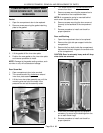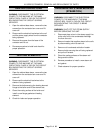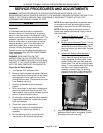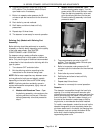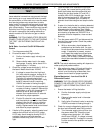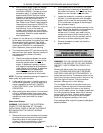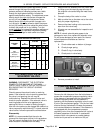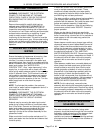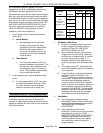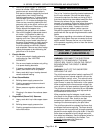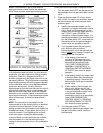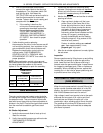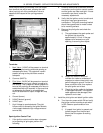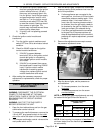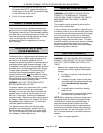
VL SERIES STEAMER - SERVICE PROCEDURES AND ADJUSTMENTS
Pa
g
e 28 of 88
If the blowdown operation appears to function
slu
gg
ishly or not at all, considerable scalants may
be lod
g
ed in the drain pipe and/or the valve.
Disconnect the valve from the drain line and inspect
both the valve and the drain pipe fixed to the boiler.
If considerable scalants or lime build up is apparent,
then not only the valve, but also the boiler and water
level probes must be thorou
g
hly cleaned. See “FILL
AND COLD WATER SOLENOID VALVES” for an
inspection and cleanin
g
procedure of a solenoid
valve and "BOILER” for a procedure on boiler
inspection, clean out and delimin
g
.
1. If your steamer has an automatic blowdown
drain valve.
A. Newer Models
1) Are equipped with normally open
solenoid valves that close when
ener
g
ized by the main power switch.
When the main power switch is
turned off, the solenoid valve is de-
ener
g
ized and the boiler blowdown
valve re-opens.
B. Older Models
1) Turn the power switch(s) OFF and
press the blowdown timer button. This
activates the boiler blowdown timer
and ener
g
izes (opens) the solenoid
valve. Timer operates approximately
four minutes then shuts off.
2. If your steamer has a manual blowdown drain
valve.
A. Turn the power switch(s) OFF then open
the valve to blowdown the boiler. Close
the valve at the end of the blowdown
sequence so boiler will be ready to fill.
BOILER SLOW TO PRESSURIZE
If the boiler requires more than 15 minutes (20
minutes for re
g
enerated models) to achieve normal
operatin
g
pressure as listed in below, then check the
followin
g
conditions.
NORMAL OPERATING STEAMER PRESSURES (PSI)
CONTROL
TYPE
VL
MODELS
CYCLING HIGH LIMIT
ON OFF ON OFF
With
Compartment
Pressure
Regulating Valve
PS
9 11615
AS
SS
MS
With-Out
Compartment
Pressure
Regulating Valve
AS
46215SS
MS
1. All Models (With Boiler)
A. Check for low water pressure input, line
strainer clo
gg
ed or fill solenoid valve
malfunction. See “FILL AND COLD
WATER SOLENOID VALVES”.
B. Boiler blowdown solenoid valve may be
clo
gg
ed and not fully closin
g
. Check for a
slow leak out of steamer drain. If not able
to verify, then proceed to step 1C. If
blowdown solenoid valve appears to be
functionin
g
properly, then proceed to step
1D.
C. Turn power switch OFF, disconnect lead
wires from blowdown solenoid and remove
it for inspection.
D. A heavy build-up of scalants has possibly
coated the interior of the boiler. The
insulatin
g
effect of the scalants hampers
heat transfer. Unbolt and remove the hand
hole cover plate and
g
asket assembly.
Examine interior of boiler and if scalants
and/or lime build up is apparent, perform a
boiler inspection, clean-out and delimin
g
procedure. See “BOILER”. If considerable
scalants are evident, then both the boiler
blowdown solenoid valve and the water
level probes must also be examined.
2. Gas Models
A. Low incomin
g
g
as pressure causes
reduced BTU output. Check incomin
g
line
and manifold
g
as pressures as outlined in
“GAS MANIFOLD PRESSURE
ADJUSTMENT.”
B. Gas combination control valve
malfunction. Check incomin
g
and manifold
g
as pressures as outlined in “GAS
MANIFOLD PRESSURE ADJUSTMENT.”
If pressure adjustments are made and
manifold pressure remains low, replace
the combination valve and check for
proper operation.



